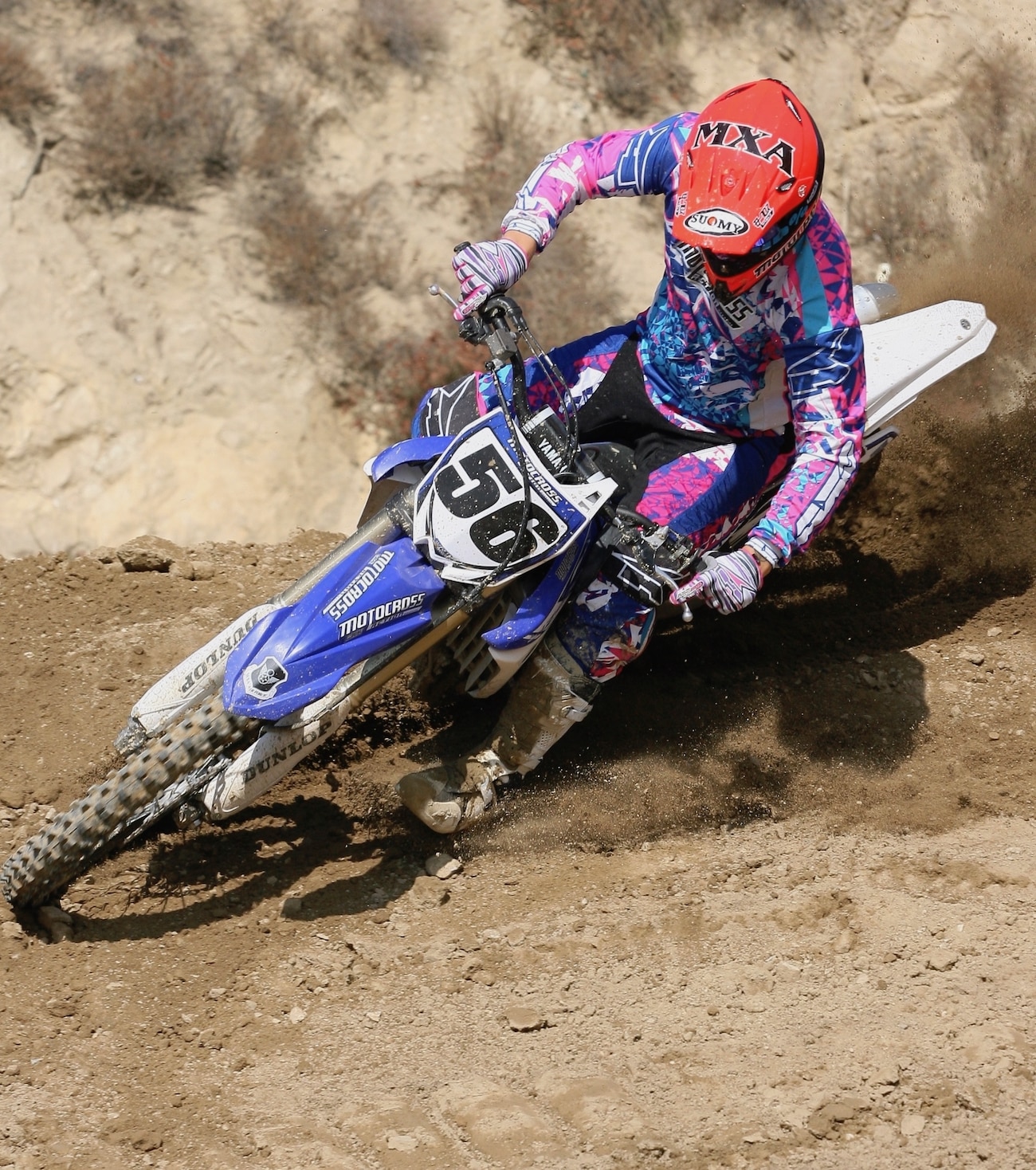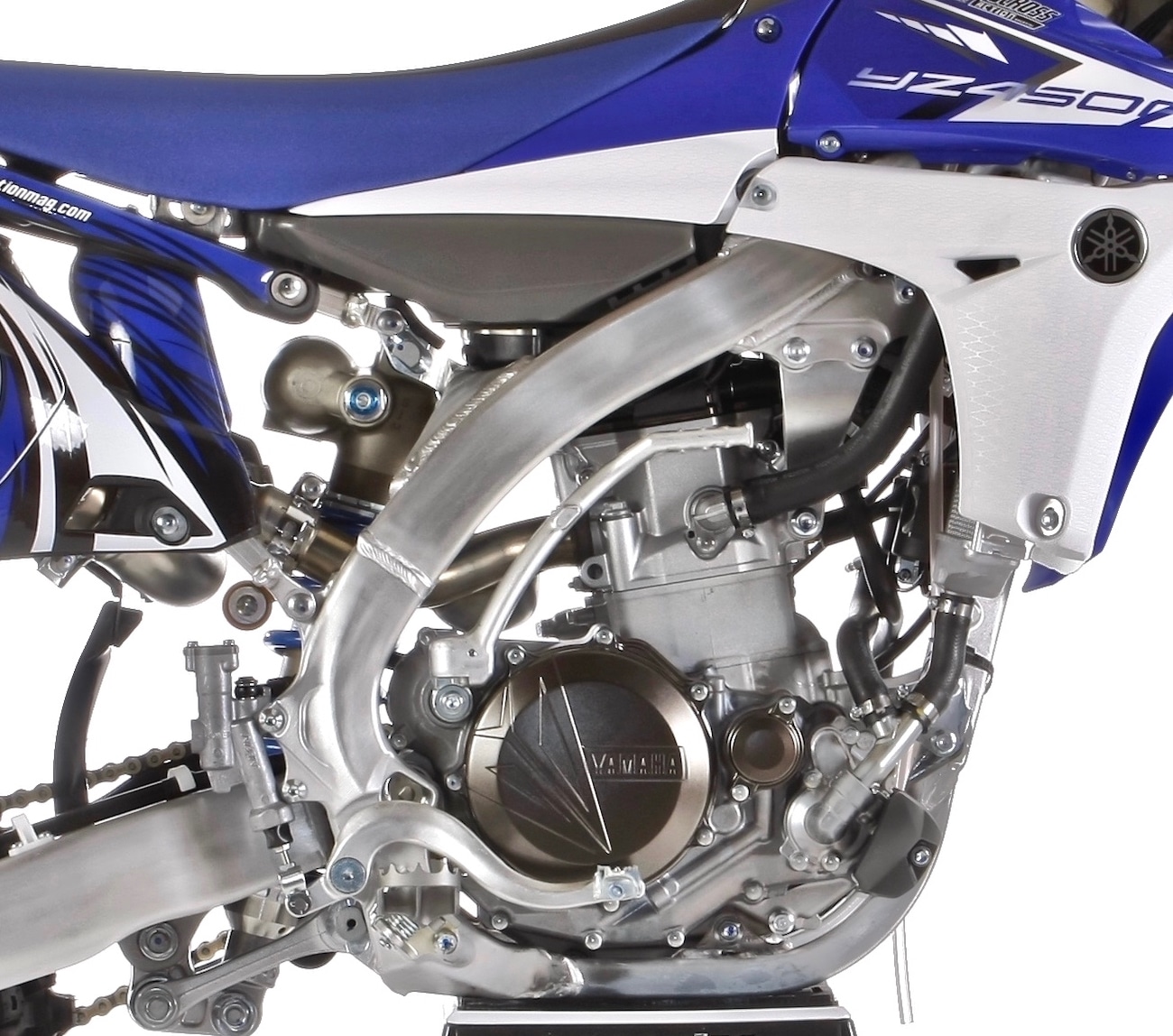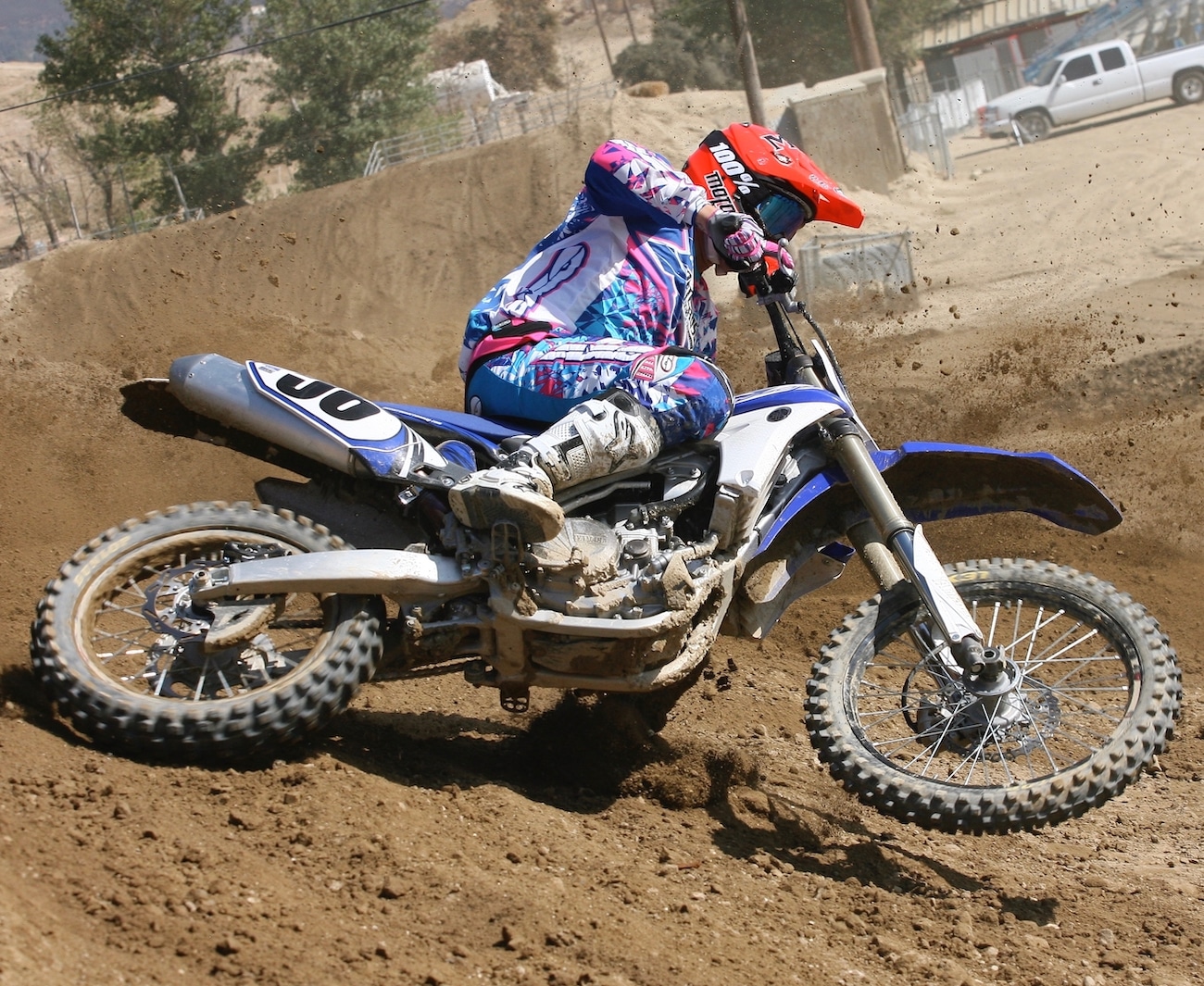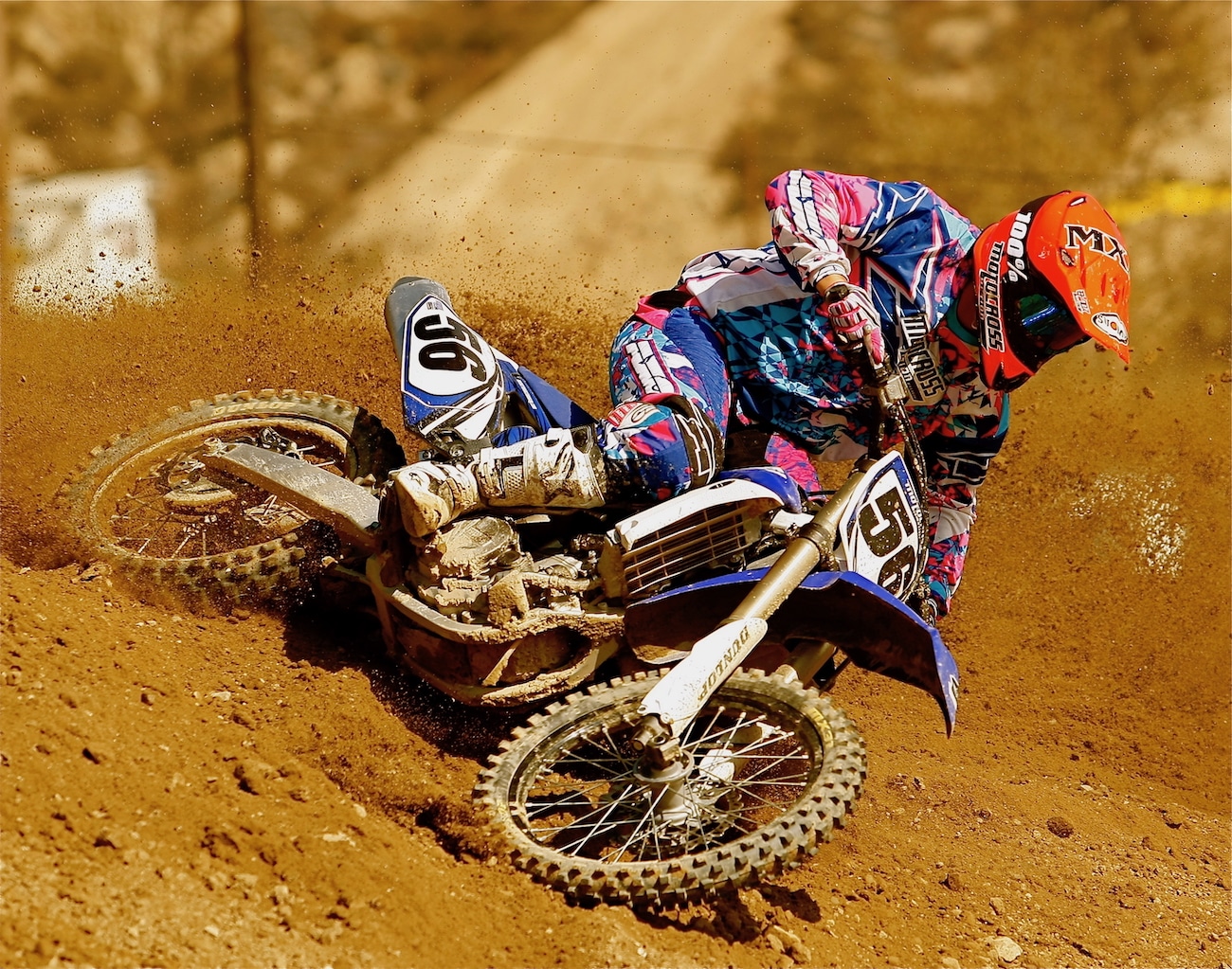TEN YEARS AGO TODAY: COMPLETE TEST OF THE 2013 YAMAHA YZ450F
Q: FIRST AND FOREMOST, IS THE 2013 YZ450F BETTER THAN THE 2012
A: No. The only changes for 2013 are a white rear fender and black handlebars. The bike was changed a little between 2011 and 2012, with revised mapping, new valving, a beefed-up shift-fork pin, a longer muffler and new MX51 tires. It should be noted that the 2011 model was a warmed-over 2010 YZ450F (with the only 2011 mechanical mod being a new clutch actuation arm).
Q: WHAT IS “THE PENALTY OF TAKING THE LEAD?”
A: When an inventor, designer, manufacturer or corporation comes out with a creative new idea, like a backwards engine, they are burdened with the responsibility of proving the worth of the idea. Consumer resistance is very high against radical ideas, and if the consumer doesn’t embrace it right away, the manufacturer must pay the penalty of taking the lead. They must convince the public by buying advertising, hiring factory riders and do everything in their power to prove that their idea is a good one.
Why is it called the “penalty of taking the lead?” Because the second inventor, designer, manufacturer or corporation that comes along and adopts the same idea, but eliminates some of the flaws of the original idea, gets the benefits of all the hard work that came before. They don’t have the penalty of newness—because the idea isn’t new anymore. That means that Yamaha has to convince you that their backwards engine idea is good, but if Honda came out with an almost identical engine next year, they would simply profit from Yamaha’s public relations work—even though Yamaha never convinced the public.
Q: WHAT IS THE MAJOR OBSTACLE SLOWING THE SUCCESS OF THE YZ450F?
A: Public relations. The YZ450F was the victim of a public relations nightmare—courtesy of James Stewart. When Stewart successfully got out of his Joe Gibbs Yamaha contract (after crashing many times on the YZ450F), the Yamaha was tainted by its association with Stewart’s troubles.
Stewart implied that he broke his long-term multi-million-dollar Joe Gibbs contract to get away from the YZ450F. It should be noted that Bubba won 17 Supercrosses on the Yamaha YZ450F between 2009 and 2012; one-third of those wins came on the backwards-engine YZ450F. But when Stewart left Yamaha, his minions pointed to the YZ450F as the cause of all of his crashes. Guess what? Since leaving Yamaha, James has crashed his new Suzuki RM-Z450 just as much, maybe more than he crashed his Yamaha or Kawasaki.
Does that mean that the Suzuki RM-Z450 is no good? No more than when Stewart complained about the Yamaha YZ450F or the Kawasaki KX450F. Stewart is a crasher with a reputation for the worst bike setup skills in the sport. He lost the front end of the Suzuki just as he lost the front end of the Yamaha. So ,despite his besmirching the YZ450F’s reputation, his crashing has continued—even on the best-turning bike in the biz.
Q: WAS STEWART WRONG ABOUT THE YAMAHA YZ450F?
A: Not for him. Bubba had lost confidence in the JGR YZ450F, and for a professional athlete, confidence is a major factor in his ability to perform. But Stewart’s troubles are incidental to MXA’s interest in the 2013 YZ450F. He is a highly paid professional rider who has to make the moves that he thinks are best for his relatively short career. And, in his defense, MXA has its own complaints about the 2010-2013 YZ450F chassis. It has a loose feel on the entrance to turns that displays itself as a wiggle. Its abrupt power delivery lifts the front end under acceleration, and the combination of no weight on the front and the loose sensation at turn-in causes the front end to push at the least opportune times.
Q: IS THERE A QUICK FIX FOR THE 2013 YAMAHA YZ450F’S HANDLING?
A: Yes. Taming the manners of the YZ450F all boils down to proper setup, which is why James Stewart could not get on with it. The MXA test riders’ main goal with the 2013 Yamaha YZ450F was to adjust the ride height, fine-tune the suspension and balance the bike to keep the front wheel planted in the corners. We also tuned the powerband to maximize grip from low to mid—even if it meant sacrificing pure power. Some of MXA’s mods are simple and some are complex, but they all cost money.
Q: HOW DO YOU MAXIMIZE THE YZ450F POWERBAND FOR GRIP?
A: First, you need to accept that the 2013 YZ450F and by association the 2010-2012 YZ-Fs are more hard-hitting than super fast. The backwards engine is very barky and abrupt off the bottom. Although it makes very good horsepower on the dyno, it is basically a low-to-mid engine on the track. The aggressive power off idle makes it a holeshot machine, because it literally jumps off the line; however, that abruptness means that it also jumps out of ruts and tight turns when you don’t want it to.
 2013 Yamaha YZ450F: This bike is defined by two attributes. First, it has the best showroom stock suspension and, second, it is bulletproof.
2013 Yamaha YZ450F: This bike is defined by two attributes. First, it has the best showroom stock suspension and, second, it is bulletproof.
The MXA test crew made a series of mods, some that contradicted each other, with the full understanding that motocross setup is a dance with many intricate moves. Here are our four major mods.
(1) Gearing. We geared it down from a 49-tooth sprocket to a 50. Yes, we knew that lowering the gearing would make it more abrupt, but we had other ways to handle that. We geared it down to get to third gear sooner, tighten up the gaps and ease the pressure on the upshift from second to third.
(2) Mapping . We remapped it. We tested five different maps to try to find the best combination of power and drive. Shockingly, our Pro test riders preferred the richest and most retarded setting, while the Novices and Vets opted for less extreme ignition and fuel settings. Either way, we retarded the ignition and richened the fuel down low to eliminate the bark that hampered cornering. Without the violent hit off the bottom, the front wheel didn’t get light under acceleration. Our only explanation for why our faster test riders preferred the most retarded ignition and fuel settings was because they carried more speed and didn’t need the bark to get going. The slower test riders also retarded the hard hit, but left a little more of it since their exit speed was slower.
(3) Flywheel weight. We ran a 9-ounce Steahly flywheel weight. We loved what this mod did for the chassis as much as we loved what it did to broaden the power delivery. Once we installed the flywheel weight, the Pro test riders returned to the stock mapping because they could let the weight mute the bark instead of the ignition. You can contact Steahly at www.steahlyoffroad.com .
(4) Exhaust. The stock YZ450F muffler is very choked down. It has grown 2 inches longer while being squeezed down from 33mm to 30mm since 2011. The combination of a longer canister and smaller core slows the revs down, hampers throttle response and delays the transition across the middle to the top.
Q: HOW DOES IT RUN ON THE DYNO?
A: It is better on the dyno than it is on the track. Max horsepower is 55.24 ponies. That is a very good peak horsepower number, but, strangely, the dyno numbers make you think that the engine favors high-rpm, top-end attacks. Not so. It is a low-to-mid powerband on the track. The powerabnd would be much better if it acted as one unified curve from bottom to top instead of three separate parts.
Q: HOW DOES THE 2013 YZ450F HANDLE?
A: It’s far from perfect, but, not surprisingly, the MXA test riders have issues with the handling of the majority of 2013 bikes. Most test riders complain that the YZ450F front end is loose on the entrance to turns and then lifts on the exit. The effect of the light front end at the crux moment of cornering causes the bike to step out when it should be going forward. It likes sand, berms and good dirt. It doesn’t like flat turns, ruts or mud. It is not a scary bike to race—just irritating.
This is nothing new. Before the advent of the backwards-engine design in 2010, the 2009 YZ450F pushed in the center of the corner (as opposed to the entrance). Our fixes all revolved around balanced power, balanced suspension and a balanced chassis.
 Left-handed compliment: We geared the YZ450F down, but not to make it hit harder, but instead to get to third sooner.
Left-handed compliment: We geared the YZ450F down, but not to make it hit harder, but instead to get to third sooner.
Q: WHAT DID MXA CHANGE ON THE 2013 YZ450F TO IMPROVE HANDLING?
A: We think our engine mods go a long way toward calming down the chassis, but we have tested a potpourri of frame and chassis mods. Here is how we rate them.
(1) Shock linkage. By swapping out the stock rising-rate linkage for a longer Pro Circuit arm, we lowered the rear of the bike, which allowed a wider range of setup options in terms of fork height, race sag and suspension settings. For more info, go to www.procircuit.com.
The Pro Circuits linkage was better than the stock YZ450F link Ishown above). It lowered the rear of the 2013 YZ450F and opened up more set-up options..
(2) Front brake. Yamaha’s front brake is adequate, but not much more than workmanlike. We swapped the stock 250mm front rotor for a 270mm oversize brake kit.
(3) Engine relocation kit. Moving the engine forward puts more weight on the front wheel to help the front bite. A cheap solution is to move your rear axle as far back as possible. This also moves the engine’s weight bias forward.
(4) Radiator lowering kit. Surprise! Test riders could feel the difference and liked it.
(5) Triple-clamp offset. No offense to triple-clamp manufacturers, but we never found an offset that worked better than the stock 22mm offset. Oh, don’t get us wrong; we could feel the difference, but we just didn’t like it.
(6) Airbox mods. We run Twin Air’s $250 Power Flow airbox. It uses a green weenie-style air filter that flows more air, makes less noise and is slightly easier to change.
Q: WHAT DOES THE 2013 YZ450F WEIGH?
A: 238 pounds. It is lighter than the KTM, Suzuki or Kawasaki, but heavier than the Honda.
Q: WHAT IS THE BEST ATTRIBUTE OF THE 2013 YAMAHA YZ450F?
A: Reliability. This is a rock-solid machine. If you are racing on a budget and can’t afford any four-stroke catastrophes, the YZ450F is the best bike for you.
 Slant nose: We have no complaints with the engineering on the backwards engine, but wish it had a broader powerband.
Slant nose: We have no complaints with the engineering on the backwards engine, but wish it had a broader powerband.
Q: WHAT DID WE HATE?
A: The hate list:
(1) Airbox. How do we hate thee? Let us count the ways. It’s loud. It’s complicated. It’s wide. It’s the epitome of afterthought engineering. Believe it or not, Yamaha uses more bolts to hold the filter than the engine.
(2) Weight. This bike would be so much better at 230 pounds, but even then it would still feel very wide.
(3) Brakes. There is no crime in not having the most powerful brakes, but no honor in not having them, either.
Q: WHAT DID WE LIKE?
A: The like list:
(1) Reliability. Unless a black cloud follows you around, the YZ450F will never break.
(2) Spring preload. The shock preload ring is easy to get to.
(3) GYTR Power Tuner. It’s more like a Playstation than a reprogramming tool. It is a small, relatively inexpensive, self-contained device that allows the fuel map and ignition timing to be changed in 30 seconds or less.
(4) Clutch. Second only to KTM’s phenomenal hydraulic unit, the YZ450F clutch can take the abuse.
Q: WHAT DO WE REALLY THINK?
A: What can Yamaha do to restore the confidence in their brand that James Stewart destroyed? MXA does not believe that Yamaha has to throw the complete design away and start over?although we wouldn’t reject that idea if they had the R&D budget to support it. Instead, we believe that the 2013 YZ450F has a solid, working platform that may not have jived with Bubba’s strange suspension settings, but will work for 99.9 percent of the racing public. It does, however, need some tweaks from the factory to go forward from here. What tweaks?
(1) Fix the handling with new motor mounts, a longer swingarm or new frame geometry.
(2) Broaden the powerband with mapping and more crank inertia.
(3) Install a front brake that is as capable as KTM’s 260mm Brembo.
(4) Do something about the atrocious airbox design (and its ultra-wide radiator wings). New plastic all-around would be a wonderful idea because the stuff that on is on there now is not only two bulbous, but it has way too many pieces.
(5) Put it on Jenny Craig until it loses 10 pounds.
THIS IS HOW WE SET OUT 2013 YAMAHA YZ450 UP FOR RACING
 We never found an offset that worked better than the stock 22mm offset. Oh, don’t get us wrong; we could feel the difference, but we just didn’t like it.
We never found an offset that worked better than the stock 22mm offset. Oh, don’t get us wrong; we could feel the difference, but we just didn’t like it.
KAYABA SSS FORK SPECS
Yamaha has the best showroom stock suspension sold. The Kayaba SSS suspension is so good that the MXA test riders had no major complaints. The damping keeps the forks high in their stroke so they maintain considerable travel for upcoming bumps. It is important that you get the chassis level by adjusting sag and fork height so that neither end is overloaded.For hardcore racing, these are MXA’s recommended 2013 Yamaha YZ450F fork settings (stock settings are in parentheses):
Spring rate: 0.47 kg/mm
Oil quantity: 355cc
Compression: 10 clicks out (9 clicks out)
Rebound: 9 clicks out (11 clicks out)
Fork-leg height: 0mm up
Notes: We had no major problems with the YZ450F’s Kayaba SSS forks. We prefer to run the compression setting stiffer than normal because it helps balance out the chassis and reduce the wiggle.
 Because of YZ450F’s wrap-around exhaust, Yamaha had to move the shock reservoir so it pointed to the left.
Because of YZ450F’s wrap-around exhaust, Yamaha had to move the shock reservoir so it pointed to the left.
KAYABA SHOCK SETTINGS
Yamaha revised the rebound damping of the 2012 shock, so they didn’t touch it for 2013. Most MXA test riders slowed down the rebound to 14 clicks out, which would be comparable to the 11 clicks out that we ran back in 2011. For hardcore racing, these are MXA’s recommended 2013 YZ450F shock settings (stock settings are in parentheses):
Spring rate: 5.7 kg/mm
Race sag: 100mm
Hi-compression: 1-1/2 turns out (1-1/4 turns out)
Lo-compression: 7 clicks out (8 clicks out)
Rebound: 14 clicks out (17 clicks out)
Notes: Most MXA test riders prefer less high-speed compression and more rebound. We also run a longer Pro Circuit shock linkage (not solely for suspension purposes, but also to give us more adjustment room with the head angle and frame geometry). The longer link will drop the rear of the bike almost 10mm, so you will need to slide the forks up to keep the bike level.











Comments are closed.